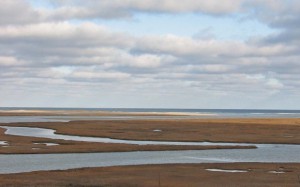Technology developed with NCCOS funding is rapidly advancing harmful algal bloom (HAB) monitoring capabilities nationwide. These cutting edge detection tools are now commercially available and transitioning them to sustained management operations is the new norm.

Recently a U. S. National Park Service (NPS) funded study benefited from the use of the NCCOS-developed ‘underwater microscope’ Imaging Flow Cytobot (IFCB) to identify harmful algal blooms in the Nauset Marsh at Cape Cod National Seashore, Massachusetts. NCCOS also supported development and deployments of the ‘laboratory in a can’ Environmental Sample Processor (ESP) in the Gulf of Maine containing an array of HAB toxin and cell sensors. Soon simultaneous deployments of the IFCB and the ESP will enable in-depth studies to investigate linkages between harmful algae bloom dynamics, toxin production, and shellfish toxicity in situ, and give early warnings of impending toxic events.
With both the IFCB and ESP now commercially available, regional observing systems, academic labs, and government agencies in the U. S. incorporate these instruments into their monitoring, research, and event response programs.

In addition to the NPS, NCCOS partners currently using these instruments include the Central and Northern California Ocean Observing System (CeNCOOS), Monterey Bay Aquarium Research Institute, NOAA Northwest Fisheries Science Center, Northeastern Regional Association of Coastal and Ocean Observing Systems (NERACOOS), Northwest Association of Networks Ocean Observing System (NANOOS), Southern California Coastal Ocean Observing System (SCCOOS), Texas A&M University, Texas Parks and Wildlife Department, University of California Santa Cruz, University of Washington, and Woods Hole Oceanographic Institution.
Learn more about the Nauset Marsh HAB study, the IFCB, ESP, and the growing threat of HABs in a six and a half minute video from the Woods Hole Oceanographic Institution, ‘ Setting a Watchman for Harmful Algal Blooms.’
For more information, contact Quay.Dortch@noaa.gov and Marc.Suddleson@noaa.gov
